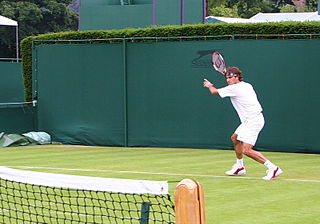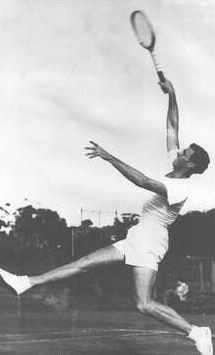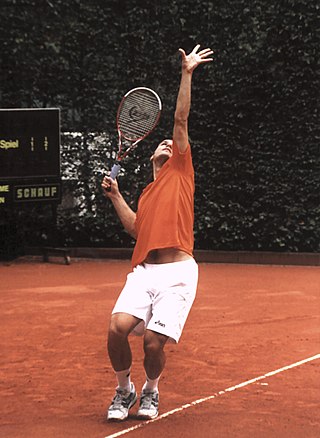
A lob in tennis involves hitting the ball high and deep into the opponent's court. It can be used as an offensive or defensive weapon.

A lob in tennis involves hitting the ball high and deep into the opponent's court. It can be used as an offensive or defensive weapon.
A lob is usually hit when an opponent is standing near the net, waiting to volley. The ball should pass over the opponent and into the open court behind. A good offensive lob cannot be reached by the opponent, yet it is low enough and has enough pace and spin so that the opponent can not run back and chase it down. It can win the point outright, although with some risks involved. Topspin greatly enhances the effectiveness of an offensive lob but also makes the stroke more difficult. When executing the lob, players usually hit the ball at an angle between 0 degrees (flat) and 45 degrees (diagonal). Some players, such as Andre Agassi, Michael Chang, Andy Murray and Lleyton Hewitt, have developed good offensive lobs.[ citation needed ]
A defensive lob requires the opponent to retreat to the baseline and prolongs the point. When a player is out of court, playing a defensive lob can buy time to run back and adopt a better defensive position.
An unsuccessful lob is susceptible to being smashed.
In doubles, spin or slice is applied to the lob, so it will go over the head of a player at the net and bounce away from the baseline player.
Some players are able to manipulate a lob so that it appears the shot is overhit, but dips enough to fall within the baseline, often deceiving the opponent. This is created by generating a great amount of backspin, slicing or cutting the ball over the head of the other player. This shot, which can also be hit with tremendous topspin, is called a "moon volley or moon lob.
The lob was introduced by Frank Hadow, the second Wimbledon champion, in his defeat of Spencer Gore. [1]
Grass courts dominated the early Grand Slams, with three of the four major tournaments featuring the soft surface of the natural ground. Because of this, the ball could always touch the grass on the field, and later on, in a match, such coverings became torn resulting in poor bounces. [2] This made the majority of players to prefer to serve as well as volley to avoid bad bounces. Initially, there were two significant styles of playing tennis.
There was Australia's style, as well as, American style. The Aussies were proponents of the "one grip fits all" philosophy, and stripped tennis down to its bare basics. The rule insisted that if one had to use "one grip for all," it needed to be the continental grip. In addition to that continental grip, their primary tactic was to serve and volley, but they also applied the backhands. Their weakest area was the forehand.
The second evolution was the reverse forehand lob. This lob became associated with the tennis player Pete Sampras. Sampras, even today, remains cemented among the legendary for his huge serve. The reverse forehand lob was a newly designed passing shot, for this the forehand became a stable of the current passing shot. This shot was to be either a short hit, a sharp crosscut, or maybe hit deep up the line.
Most of the tennis court offers a lot of space near the baseline, and this has led the majority of players to stand at the baseline and attempt the standing back lob. This maneuver was mostly for the defensive players, as they used it to strike the ball faster, as well as, at sharp angles, mainly during the 1970s.
The windshield-wiper forehand can also provide a lob shot in tennis. During the old days, the forehand was often accompanied by a high follow-through. Used by players such as Pete Sampras, it reached its novelty in the 1990s but became the staple in the 2000s.
The next type of lob that appeared on the tennis scene was called the "squash shot forehand," it was a defensive lob, and it was great during its day. [3] Today this shot offers a solution to the sole forehand. In the old days, the "Recovery slice backhand" lob was used to approach the net. In addition to that, it was more offensive shot. Today it is used to recover.
"The swinging volley," was an innovation of Lendl’s. It employed strong topspin forehands and even more of the volley. It is also used today by players such as Roger Federer but was more common in the 1980s. Big servers used it the most.
The "kick serve" lob has been in use for the relatively extended period.[ vague ] [4] Though it has little fame, it is still used to have the ball "kick" over the opponents head during serving.

Badminton is a racquet sport played using racquets to hit a shuttlecock across a net. Although it may be played with larger teams, the most common forms of the game are "singles" and "doubles". Badminton is often played as a casual outdoor activity in a yard or on a beach; formal games are played on a rectangular indoor court. Points are scored by striking the shuttlecock with the racquet and landing it within the other team's half of the court.

Tennis is a racket sport that is played either individually against a single opponent (singles) or between two teams of two players each (doubles). Each player uses a tennis racket that is strung with cord to strike a hollow rubber ball covered with felt over or around a net and into the opponent's court. The object of the game is to manoeuvre the ball in such a way that the opponent is not able to play a valid return. The player who is unable to return the ball validly will not gain a point, while the opposite player will.

Table tennis is a racket sport derived from tennis but distinguished by its playing surface being atop a stationary table, rather than the court on which players stand. Either individually or in teams of two, players take alternating turns returning a light, hollow ball over the table's net onto the opposing half of the court using small rackets until they fail to do so, which results in a point for the opponent. Play is fast, requiring quick reaction and constant attention, and is characterized by an emphasis on spin relative to other ball sports, which can heavily affect the ball's trajectory.
A volley in tennis is a shot in which the ball is struck before it bounces on the ground. Generally a player hits a volley while standing near the net, although it can be executed farther back, in the middle of the tennis court or even near the baseline. The word derives from M. French volée meaning flight.
In tennis, a grip is a way of holding the racquet in order to hit shots during a match. The three most commonly used conventional grips are: the Continental, the Eastern and the Semi-Western. Most players change grips during a match depending on what shot they are hitting.

The forehand in tennis and other racket sports such as table tennis, squash and badminton is a shot made by swinging the racket across one's body with the hand moving palm-first. In tennis, except in the context of the phrase forehand volley, the term refers to a type of groundstroke—a stroke in which the ball has bounced before it is struck. It contrasts with the backhand, the other type of groundstroke. For a right-handed player, the forehand is a stroke that begins on the right side of the body, continues across the body as contact is made with the ball, and ends on the left side of the body. It is considered the easiest shot to master, perhaps because it is the most natural stroke. Beginners and advanced players often have better forehands than any other shots and use it as a weapon.

The backhand is a shot used in most racket sports, such as tennis, table tennis and pickleball, where the back of the hand precedes the palm when swinging the racket. Except in the phrase backhand volley, the term refers to a groundstroke. It contrasts with the forehand stroke, where the palm precedes the back of the hand. The term is also used in other sports where a similar motion is employed, such as throwing a sport disc.
In racket sports a groundstroke, or ground stroke, refers to a forehand or backhand shot that is executed after the ball has bounced on the court. The term is commonly used in the sports of tennis and pickleball, and is counter to a volley shot which is taken before the ball has bounced. Groundstrokes in tennis are usually hit from the back of the court, around the baseline.
A drop shot is a shot in some racket sports in which the ball is hit relatively softly, sometimes with topspin or backspin, so that it lands just over and close to the net. A well-placed and well-timed drop shot will make it difficult for the opposing player to hit an aggressive or offensive shot in return. The most successful drop shots will not allow the opponent to hit the ball back at all.

A smash in tennis is a shot that is hit above the hitter's head with a serve-like motion. It is also referred to as an overhead. A smash can usually be hit with a high amount of force and is often a shot that ends the point. Most smashes are hit fairly near the net or in mid-court before the ball bounces, generally against lobs that have not been hit high enough or deep enough by the opponent. A player can also smash a very high ball from the baseline, generally on the bounce, although this is often a less forceful smash.
In tennis, there are a variety of types of shots which can be categorized in various ways. The grip you place on will help you have different types of shots, the lower your grip means that the ball is most likely going to be a ground stroke. According to William T. Tilden, "All tennis strokes, should be made with the body' at right angles to the net, with the shoulders lined up parallel to the line of flight of the ball." The serve is the opening shot of a point. Groundstrokes are hit after the ball has already bounced, and can be either forehands or backhands depending on which direction the racket is swung relative to the body. A lob is a groundstroke hit well over the head of an opponent who is positioned at the net. A passing shot is a groundstroke that is hit out of reach of an opponent at the net far to his left or right. A cross-court shot is a shot hit from the left side of one player's court to the left side of the other player's court, so that it crosses the lengthwise centerline of the court. A down-the-line shot is one that is hit more or less parallel to, and near to, one of the sidelines, so that it never crosses the centerline.
This page is a glossary of tennis terminology.
Players use different strategies while playing tennis to enhance their own strengths and exploit their opponent's weaknesses in order to gain the advantage and win more points.
Table tennis is unique among racket sports in that it supports a wide variety of playing styles and methods of gripping the racket, at even the highest levels of play. This article describes some of the most common table tennis grips and playing styles seen in competitive play. The playing styles listed in this article are broad categories with fuzzy boundaries, and most players will possess some combination of these styles while leaning towards a "favorite". Many advanced players will also add some "special" shots of their own.

In ball sports, topspin or overspin is a property of a ball that rotates forwards as it is moving. Topspin on a ball propelled through the air imparts a downward force that causes the ball to drop, due to its interaction with the air. Topspin is the opposite of backspin.

Dream Match Tennis is a 2006 tennis simulation game developed by Bimboosoft, a company based in Saitama, Japan. Unlike other games in its genre, Dream Match Tennis was aimed to produce a more realistic depiction of the sport, requiring more skill from the player in order to direct their shots accurately.

A passing shot is a forceful shot, as in tennis or team handball, that travels to one side out of the reach of one's opponent. In tennis, this shot is generally a groundstroke and is used when one's opponent is running to the net or if they are at the net already. The alternative to a passing shot is to lob the ball over the opponent's head. The aim of the passing shot in tennis is to prevent the opponent from returning the ball once he/she is at the net.

A serve in tennis is a shot to start a point. A player will hit the ball with a racquet so it will fall into the diagonally opposite service box without being stopped by the net. Normally players begin a serve by tossing the ball into the air and hitting it. The ball can only touch the net on a return and will be considered good if it falls on the opposite side. If the ball contacts the net on the serve but then proceeds to the proper service box, it is called a let; this is not a legal serve in the major tours although it is also not a fault. Players normally serve overhead; however serving underhand is allowed. The serve is the only shot a player can take their time to set up instead of having to react to an opponent's shot; however, as of 2012, there is a 25-second limit to be allowed between points.
This glossary provides definitions and context for terminology related to, and jargon specific to, the sport of pickleball. Words or phrases in italics can be found on the list in their respective alphabetic sections.